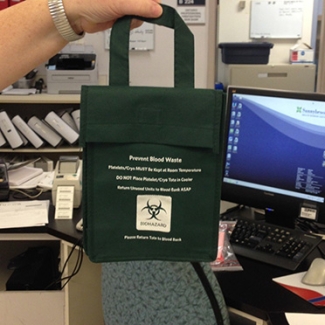Treating iron deficiency with oral iron supplements: what is the best dosing frequency?
Thursday, February 23, 2023 Harley Meirovich
Harley Meirovich is a clinical research coordinator in transfusion medicine at Sunnybrook Research Institute in Toronto and is a member of the University of Toronto QUEST transfusion research program, a research collaborative supported by Canadian Blood Services. QUEST researchers conducted a study that will inform treatment of iron deficiency, a possible outcome for frequent blood donors.
Anemia, which affects approximately 33% of the world’s population, occurs when there is not enough hemoglobin in red blood cells to carry oxygen to the body’s tissues. Iron is a major component of hemoglobin, and iron deficiency anemia (IDA) is a condition that occurs when the body does not have enough iron to make healthy red blood cells. IDA affects 1–2% of males and 2–5% of females globally. Symptoms of IDA can include negative effects on physical and mental functioning, fatigue, weakness, hair loss, pica (where people have cravings for things not usually considered food, like ice and dirt), shortness of breath, and restless legs.
Taking oral iron supplements can help to improve the negative impacts of IDA. Oral iron–in the form of daily pills—is the recommended first line therapy in the management of IDA due to its ease of administration, wide availability, and low cost. However, approximately 30–70% of patients experience side effects when taking oral iron. These side effects can include constipation, nausea, vomiting, diarrhea, abdominal discomfort, heartburn, and headaches. Previous studies have found that taking oral iron supplements every other day (referred to as intermittent oral iron dosing) had a similar effect to daily oral iron dosing in terms of lowering the prevalence of anemia and increasing hemoglobin (a measurement of red blood cell levels). Interestingly, these studies found that intermittent dosing resulted in fewer side effects compared to daily dosing. We sought to explore this further through the DEODO study – “Daily vs. Every Other Day Oral iron supplementation in patients with iron deficiency anemia (DEODO): A pilot randomized controlled trial.”
The DEODO pilot study compared giving daily versus every other day (EOD) oral iron to patients with IDA. Participants were referred to participate in the study either by their primary care providers, or through self-referrals if they attempted to donate blood at Canadian Blood Services but could not donate because their hemoglobin was too low. Participants were randomized to receive either daily or EOD oral iron (ferrous sulfate) over the course of a 12-week study period. During that time, participants had 4 study visits (at 1, 4, 8 and 12 weeks after starting iron), to examine bloodwork, any changes in medical history or new medical concerns, and to complete questionnaires assessing fatigue and potential side effects from oral iron. A final study visit was used to follow up with participants one week after stopping their iron regimen to make sure they did not have any side effects from stopping the iron.
We were successfully able to achieve the main outcome of the study, which was to enroll 52 participants in a 34-month period (from January 2019 to October 2021, with a pause in recruitment for 8 months due to COVID-19), with a high completion rate of all of the study procedures. Our results also showed that in both the daily and EOD groups, fatigue improved and laboratory values, including hemoglobin and ferritin (a blood protein that stores iron and can be used to assess your body’s iron levels), increased; this means that participants had an increase in the levels of oxygen and iron in their blood from taking oral iron. We also found that there were no significant differences between the daily and EOD groups in terms of laboratory values, fatigue scores, or side effects. This suggests that oral iron treatment can be personalized, such that in the event of side effects, patients could potentially switch from daily to EOD dosing without being concerned that the treatment will be less effective. We hope to initiate a larger-scale study in order to further evaluate the effectiveness of daily and EOD iron dosing. We are grateful to Canadian Blood Services for supporting QUEST through the Transfusion Medicine Research Program Support Award!
Canadian Blood Services – Driving world-class innovation
Through discovery, development and applied research, Canadian Blood Services drives world-class innovation in blood transfusion, cellular therapy and transplantation—bringing clarity and insight to an increasingly complex healthcare future. Our dedicated research team and extended network of partners engage in exploratory and applied research to create new knowledge, inform and enhance best practices, contribute to the development of new services and technologies, and build capacity through training and collaboration. Find out more about our research impact.
The opinions reflected in this post are those of the author and do not necessarily reflect the opinions of Canadian Blood Services nor do they reflect the views of Health Canada or any other funding agency.
Related blog posts
New findings from University of Toronto’s QUEST research program analyze the impact of albumin on patient outcomes after cardiac surgery, suggesting routine albumin use in this patient group may need to be re-examined.
A study conducted by researchers in the University of Toronto QUEST program, a research collaborative supported by Canadian Blood Services, looked at what can be done to reduce the number of inappropriate red blood cell transfusions in hospitals.
Despite the critical and increasing demand for platelets within the health-care system, they remain the most commonly discarded blood component in Canada. Improper storage outside of the hospital blood bank is the main reason that platelets get discarded before they’ve reached the end of their 7-day shelf life. A team from University of Toronto QUEST research program tested a storage bag specially designed to address the problem of platelet discards.


